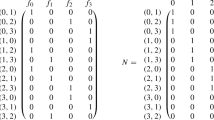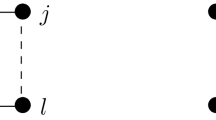Abstract
In order to model entanglements of polymers in a confined region, we consider the linking numbers and writhes of cycles in random linear embeddings of complete graphs in a cube. Our main results are that for a random linear embedding of \(K_n\) in a cube, the mean sum of squared linking numbers and the mean sum of squared writhes are of the order of \(\theta (n(n!))\). We obtain a similar result for the mean sum of squared linking numbers in linear embeddings of graphs on n vertices, such that for any pair of vertices, the probability that they are connected by an edge is p. We also obtain experimental results about the distribution of linking numbers for random linear embeddings of these graphs. Finally, we estimate the probability of specific linking configurations occurring in random linear embeddings of the graphs \(K_6\) and \(K_{3,3,1}\).









Similar content being viewed by others
References
J. Arsuaga, T. Blackstone, Y. Diao, E. Karadayi, M. Saito, Linking of uniform random polygons in confined spaces. J. Phys. A 40(9), 1925–1936 (2007)
J. Arsuaga, B. Borgo, Y. Diao, R. Scharein, The growth of the mean average crossing number of equilateral polygons in confinement. J. Phys. A 42(46), 465202, 9 (2009)
J.H. Conway, CMcA Gordon, Knots and links in spatial graphs. J. Graph Theory 7, 445–453 (1983)
Y. Diao, C. Ernst, S. Saarinen, U. Ziegler, Generating random walks and polygons with stiffness in confinement. J. Phys. A 48(9), 095202, 19 (2015)
Y. Diao, N. Pippenger, D.W. Sumners, On Random Knots, Random Knotting and Linking (Vancouver, BC, 1993), Ser. Knots Everything, vol. 7 (World Sci. Publ, River Edge, 1994), pp. 187–197
E.N. Gilbert, Random graphs. Ann. Math. Stat. 30, 1141–1144 (1959)
C. Hughes, Linked triangle pairs in straight edge embeddings of \(K_6\). Pi Mu Epsilon J. 12(4), 213–218 (2006)
Y. Huh, C.B. Jeon, Knots and links in linear embeddings of \(K_6\). J. Korean Math. Soc. 44(3), 661–671 (2007)
R. Naimi, E. Pavelescu, Linear embeddings of \(K_9\) are triple linked. J. Knot Theory Ramif. 23(3), 1420001, 9 (2014)
R. Naimi, E. Pavelescu, On the number of links in a linearly embedded \(K_{3,3,1}\). J. Knot Theory Ramif. 24, 8 (2015)
S. Negami, Ramsey theorems for knots, links and spatial graphs. Trans. Am. Math. Soc. 324(2), 527–541 (1991)
R. Nikkuni, A refinement of the Conway–Gordon theorems. Topol. Appl. 156(17), 2782–2794 (2009)
E. Panagiotou, K.C. Millett, S. Lambropoulou, The linking number and the writhe of uniform random walks and polygons in confined spaces. J. Phys. A 43(4), 045208, 28 (2010)
J. Portillo, Y. Diao, R. Scharein, J. Arsuaga, M. Vazquez, On the mean and variance of the writhe of random polygons. J. Phys. A 44(27), 275004, 19 (2011)
K. Tsurusaki, T. Deguchi, Numerical Analysis on Topological Entanglements of Random Polygons, Statistical Models, Yang–Baxter Equation and Related Topics, and Symmetry, Statistical Mechanical Models and Applications (Tianjin, 1995) (World Sci. Publ., River Edge, NJ, 1996), pp. 320–329
Acknowledgments
The first author would like to thank the Mathematical Science Research Institute for its hospitality during the Spring of 2015 which facilitated this collaboration.
Author information
Authors and Affiliations
Corresponding author
Appendix: Computing q
Appendix: Computing q
In order to obtain better estimates of the linking probabilities for \(K_6\) and \(K_{3,3,1}\), we numerically estimated the value of q. Consider two triangles described by the consistently oriented edges \(l_1,l_2,l_3\) and \(l_1',l_2',l_3'\), and let \(\epsilon _{ij}\) denote the signed crossing number between \(l_i\) and \(l_j'\). Then it follows from the proof of Lemma 2.2 in [1] that
But the quantity \(\sum _{i,j=1}^3 \epsilon _{ij}\) is precisely twice the linking number of the two triangles, which for a linear embedding is either 0 or \(\pm 1\). Hence, \(\frac{18q}{4}\) is the probability that a random linear embedding of two disjoint triangles is linked.
We wrote a Python program to generate random linear embeddings of two triangles by taking six random points in \(C^3\), described as three (pseudo)random coordinates in (0, 1), and computing the associated linking number. Out of the one billion samples generated, 152,402,780 were linked, giving a 99 % confidence interval for q of \(0.033867 \pm 0.000013\).
All code is available at http://math.berkeley.edu/~kozai/random_graphs/.
Rights and permissions
About this article
Cite this article
Flapan, E., Kozai, K. Linking number and writhe in random linear embeddings of graphs. J Math Chem 54, 1117–1133 (2016). https://doi.org/10.1007/s10910-016-0610-2
Received:
Accepted:
Published:
Issue Date:
DOI: https://doi.org/10.1007/s10910-016-0610-2




